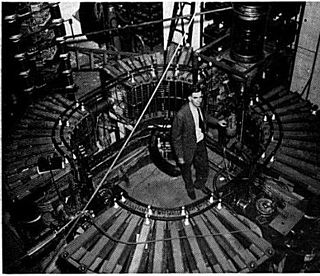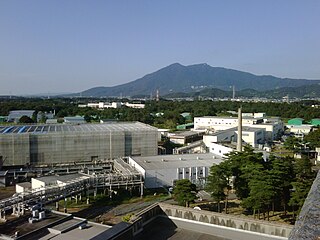Related Research Articles

A gluon is a type of massless elementary particle that mediates the strong interaction between quarks, acting as the exchange particle for the interaction. Gluons are massless vector bosons, thereby having a spin of 1. Through the strong interaction, gluons bind quarks into groups according to quantum chromodynamics (QCD), forming hadrons such as protons and neutrons.

Synchrotron radiation is the electromagnetic radiation emitted when relativistic charged particles are subject to an acceleration perpendicular to their velocity. It is produced artificially in some types of particle accelerators or naturally by fast electrons moving through magnetic fields. The radiation produced in this way has a characteristic polarization, and the frequencies generated can range over a large portion of the electromagnetic spectrum.

A synchrotron light source is a source of electromagnetic radiation (EM) usually produced by a storage ring, for scientific and technical purposes. First observed in synchrotrons, synchrotron light is now produced by storage rings and other specialized particle accelerators, typically accelerating electrons. Once the high-energy electron beam has been generated, it is directed into auxiliary components such as bending magnets and insertion devices in storage rings and free electron lasers. These supply the strong magnetic fields perpendicular to the beam that are needed to stimulate the high energy electrons to emit photons.

A synchrotron is a particular type of cyclic particle accelerator, descended from the cyclotron, in which the accelerating particle beam travels around a fixed closed-loop path. The strength of the magnetic field which bends the particle beam into its closed path increases with time during the accelerating process, being synchronized to the increasing kinetic energy of the particles.

The High Energy Accelerator Research Organization, known as KEK, is a Japanese organization whose purpose is to operate the largest particle physics laboratory in Japan, situated in Tsukuba, Ibaraki prefecture. It was established in 1997. The term "KEK" is also used to refer to the laboratory itself, which employs approximately 695 employees. KEK's main function is to provide the particle accelerators and other infrastructure needed for high-energy physics, material science, structural biology, radiation science, computing science, nuclear transmutation and so on. Numerous experiments have been constructed at KEK by the internal and international collaborations that have made use of them. Makoto Kobayashi, emeritus professor at KEK, is known globally for his work on CP-violation, and was awarded the 2008 Nobel Prize in Physics.

Two-photon physics, also called gamma–gamma physics, is a branch of particle physics that describes the interactions between two photons. Normally, beams of light pass through each other unperturbed. Inside an optical material, and if the intensity of the beams is high enough, the beams may affect each other through a variety of non-linear effects. In pure vacuum, some weak scattering of light by light exists as well. Also, above some threshold of this center-of-mass energy of the system of the two photons, matter can be created.
This is a timeline of subatomic particle discoveries, including all particles thus far discovered which appear to be elementary given the best available evidence. It also includes the discovery of composite particles and antiparticles that were of particular historical importance.

In particle physics, a three-jet event is an event with many particles in final state that appear to be clustered in three jets. A single jet consists of particles that fly off in roughly the same direction. One can draw three cones from the interaction point, corresponding to the jets, and most particles created in the reaction will appear to belong to one of these cones. These events are currently the most direct available evidence for the existence of gluons, and were first observed by the TASSO experiment at the PETRA accelerator at the DESY laboratory.

John (Jean) Iliopoulos is a Greek physicist. He is the first person to present the Standard Model of particle physics in a single report. He is best known for his prediction of the charm quark with Sheldon Glashow and Luciano Maiani. Iliopoulos is also known for demonstrating the cancellation of anomalies in the Standard model. He is further known for the Fayet-Iliopoulos D-term formula, which was introduced in 1974. He is currently an honorary member of Laboratory of theoretical physics of École Normale Supérieure, Paris.

A particle accelerator is a machine that uses electromagnetic fields to propel charged particles to very high speeds and energies to contain them in well-defined beams. Small accelerators are used for fundamental research in particle physics. Accelerators are also used as synchrotron light sources for the study of condensed matter physics. Smaller particle accelerators are used in a wide variety of applications, including particle therapy for oncological purposes, radioisotope production for medical diagnostics, ion implanters for the manufacturing of semiconductors, and accelerator mass spectrometers for measurements of rare isotopes such as radiocarbon.

Quark–gluon plasma is an interacting localized assembly of quarks and gluons at thermal and chemical (abundance) equilibrium. The word plasma signals that free color charges are allowed. In a 1987 summary, Léon Van Hove pointed out the equivalence of the three terms: quark gluon plasma, quark matter and a new state of matter. Since the temperature is above the Hagedorn temperature—and thus above the scale of light u,d-quark mass—the pressure exhibits the relativistic Stefan-Boltzmann format governed by temperature to the fourth power and many practically massless quark and gluon constituents. It can be said that QGP emerges to be the new phase of strongly interacting matter which manifests its physical properties in terms of nearly free dynamics of practically massless gluons and quarks. Both quarks and gluons must be present in conditions near chemical (yield) equilibrium with their colour charge open for a new state of matter to be referred to as QGP.
In astronomy, optics and particle physics, the Bose–Einstein correlations refer to correlations between identical bosons.
An energy recovery linac (ERL) is a type of linear particle accelerator that provides a beam of electrons used to produce x-rays by synchrotron radiation. First proposed in 1965 the idea gained interest since the early 2000s.
The photon structure function, in quantum field theory, describes the quark content of the photon. While the photon is a massless boson, through certain processes its energy can be converted into the mass of massive fermions. The function is defined by the process e + γ → e + hadrons. It is uniquely characterized by the linear increase in the logarithm of the electronic momentum transfer logQ2 and by the approximately linear rise in x, the fraction of the quark momenta within the photon. These characteristics are borne out by the experimental analyses of the photon structure function.

The Breit–Wheeler process or Breit–Wheeler pair production is a proposed physical process in which a positron–electron pair is created from the collision of two photons. It is the simplest mechanism by which pure light can be potentially transformed into matter. The process can take the form γ γ′ → e+ e− where γ and γ′ are two light quanta.

The dark photon is a hypothetical hidden sector particle, proposed as a force carrier similar to the photon of electromagnetism but potentially connected to dark matter. In a minimal scenario, this new force can be introduced by extending the gauge group of the Standard Model of Particle Physics with a new abelian U(1) gauge symmetry. The corresponding new spin-1 gauge boson can then couple very weakly to electrically charged particles through kinetic mixing with the ordinary photon and could thus be detected. The dark photon can also interact with the Standard Model if some of the fermions are charged under the new abelian group. The possible charging arrangements are restricted by a number of consistency requirements such as anomaly cancellation and constraints coming from Yukawa matrices.

The NA63 experiment aims to study the radiation process in strong electromagnetic fields. Located at CERN, in the North Area. It is a fixed-target experiment which uses the H4 secondary electron beams from the SPS, which are directed onto different targets. Those are made from a variety of elements, ranging from the relatively light carbon and silicon, through the heavier iron and tin to tungsten, gold and lead and are either amorphous or mono-crystals.

Luigi Di Lella is an Italian experimental particle physicist. He has been a staff member at CERN for over 40 years, and has played an important role in major experiments at CERN such as CAST and UA2. From 1986 to 1990 he acted as spokesperson for the UA2 Collaboration, which, together with the UA1 Collaboration, discovered the W and Z bosons in 1983.

Non-linear inverse Compton scattering (NICS), also known as non-linear Compton scattering and multiphoton Compton scattering, is the scattering of multiple low-energy photons, given by an intense electromagnetic field, in a high-energy photon during the interaction with a charged particle, in many cases an electron. This process is an inverted variant of Compton scattering since, contrary to it, the charged particle transfers its energy to the outgoing high-energy photon instead of receiving energy from an incoming high-energy photon. Furthermore, differently from Compton scattering, this process is explicitly non-linear because the conditions for multiphoton absorption by the charged particle are reached in the presence of a very intense electromagnetic field, for example, the one produced by high-intensity lasers.
Alexander Wu Chao is a Taiwanese-American physicist, specializing in accelerator physics.
References
- 1 2 "Beam Blow Up due to Beamstrahlung in Circular e+e − Colliders" ; as of 8 November 2019.
- ↑ Beamstrahlung as a Beam-Beam Diagnostic; as of 30 December 2012.
- ↑ "Limitations on Performance of e+ e- Storage Rings and Linear Colliding Beam Systems at High Energy"; as of 30 December 2012.